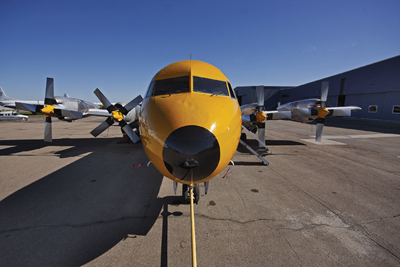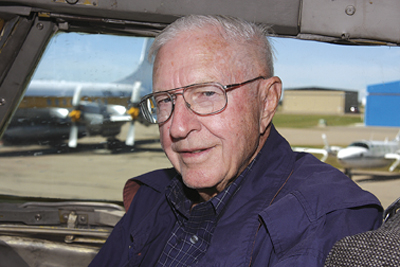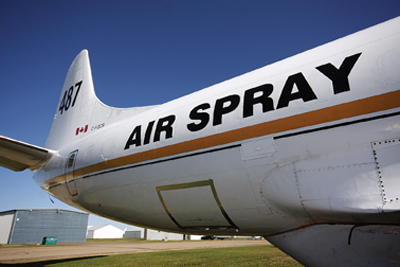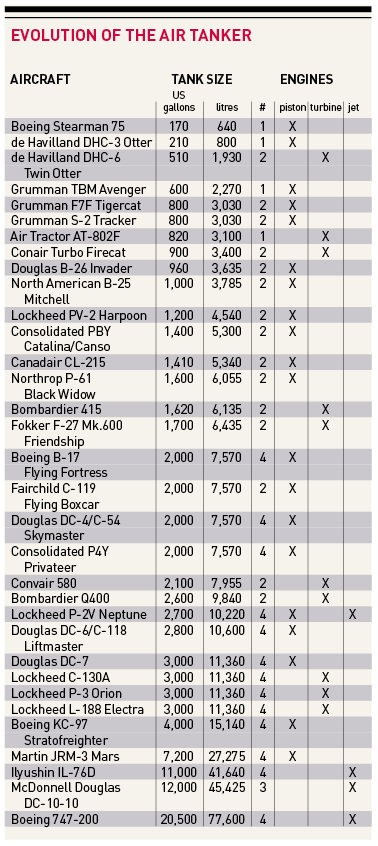
Features
Operations
Position Report: Vintage planes dousing flames
If there is one aviation activity that defines a niche business it has to be aerial firefighting. It requires customized single-purpose
November 24, 2009 By Frederick K. Larkin
A war that never ends
If there is one aviation activity that defines a niche business it has to be aerial firefighting. It requires customized single-purpose, high-performance aircraft, presents skill-testing flight profiles and provides ever-changing theatres of operation. As well, it has an extremely limited customer base and produces relatively low annual asset utilization rates due to its seasonality. Despite those characteristics, it is a livelihood that has attracted and challenged entrepreneurs for decades.
 |
|
| Air Spray’s current fleet includes seven Electras, eight Turbo Commanders, three Cessna 310s and two Aerostars.
|
The North American airborne fire suppression industry came of age in the mid-1950s when suitable aircraft became obtainable. Former military transports and bombers, such as the Consolidated Catalina/Canso, Douglas Skymaster, and Grumman Avenger were modified with tanks to hold water or fire retardant. The second generation of air tankers included 1950s vintage piston aircraft such as the Lockheed Neptune, Grumman Tracker, Douglas DC-6s and DC-7s. In later years, turbine aircraft became active with the availability of Lockheed C-130 Hercules and P-3 Orions.
Canadian companies such as The Flying Fireman of Sidney, B.C., Avalon Aviation of Red Deer, Alta., Canspec Air Transport of Calgary, Alta., and North Canada Air of Prince Albert, Sask., have long since ceased to exist. Today, five provincial governments and a handful of private operators continue to use fixed-wing aircraft to fight an enemy that perennially regroups – wildfire.
One of these companies is Air Spray (1967) Ltd. of Edmonton, Alta. Having been around for more than four decades, it is a survivor in an industry that has seen many a player burn out. Can it withstand the heat of competition and soldier on? To answer that we must first review how it got to where it is today.
That was then…
In February 1954, 27-year-old David Harrington created Airspray Ltd. in Wetaskiwin, Alta. The company provided crop dusting services with light aircraft including a Champion 7GCA Sky-Trac and a Piper PA-18A Super Cub. In July 1961, Airspray was awarded its first fire suppression contract from the Province of Alberta. Its expanded fleet now included a trio of Grumman TBM Avengers and a pair of Boeing Stearman biplanes. In 1967 Harrington renamed the company Mercury Flights Ltd., but later that year it became Air Spray (1967) Ltd.
In 1969, Dave Harrington acquired a 1945 Douglas B-26 Invader located in Richmond, B.C. After having it converted into a water bomber at Prescott, Ariz., it was ready for service in the spring of 1970. In need of working capital, Harrington approached Edmonton businessman Donald T. Hamilton. Given that Air Spray had a contract with the Alberta Forest Service, Hamilton agreed to purchase a 50 per cent interest in the B-26 for $5,000. A few years later Hamilton became the company’s sole owner and continued to grow the enterprise. Later in 1970, Air Spray was awarded a three-year contract from Alberta to operate a pair of Invaders. In 1973 it began working for the Yukon Territory’s government with another pair of B-26s. The following year, Air Spray moved its operations base from the Edmonton Industrial Airport to the Red Deer Regional Airport in Penhold, Alta., where it had room to expand.
 |
|
| Don Hamilton, owner/CEO of Air Spray
|
During the 1970s and 1980s, Air Spray provided aerial firefighting services to the governments of Alberta, British Columbia and the Yukon. The speedy B-26 was the company’s weapon of choice. Air Spray acquired an average of one Invader per year and owned 17 of them by the summer of 1988. In 1990, after Air Spray had served the Yukon for 17 years, that contract was awarded to Conair Aviation of Abbotsford, B.C.
During the 1990s, the fleet of large piston-powered air tankers in the United States began to be supplemented by turbine-driven machines. The Lockheed P-3 Orion, a four-engine turboprop, caught the eye of Don Hamilton. Aero Union of Chico, Calif., had converted a number of former U.S. Navy P-3s into air tankers and they were demonstrating attractive operational characteristics. The P-3’s civilian sibling was the Lockheed L-188 Electra, a 66-88 seat airliner. Like the P-3, the L-188 can carry 3,000 US gallons of retardant, cruise en route to its target at 380 miles per hour and perform with the required agility at the drop zone. Air Spray initiated Electra ops for the Province of B.C. in 1994 and did so for Alberta a year later. As the larger turbine aircraft met its performance expectations, the customers expressed their preference. The result was the retirement of the B-26 fleet at the end of the fire season in 2004.
Over the years Air Spray owned 22 Invaders. Despite three being destroyed in a hangar fire at Red Deer on Oct. 16, 2000, and five being written off in action, the aircraft served the company well for 35 years. In the meantime, from 1988 until 2001, Air Spray operated four Canadair CL-215 amphibians owned by the Alberta government. As well, from 1999 until 2008, the company operated a trio of its own CL-215s for Alberta. Conair was awarded the management contract for the four 215s in 2001 and Air Spray sold its three Canadairs early this past summer.
In addition to its fleet of air tankers, Air Spray has operated numerous bird dog aircraft in support of its water bombing activities. During the past 40 years the company’s bird dogs have been primarily Cessna 310s, Ted Smith Aerostars and Rockwell 690 Turbo Commanders. It has also used a Cessna 500 Citation in the bird dog role during the past 10 years. Earlier this decade, Air Spray operated a former military fighter to pursue revenues in a totally unrelated market – aerial target towing. The jet, a 1958 Canadair F-86E Mk.6 Sabre, sported the company’s bright yellow livery and served the Canadian Forces at Cold Lake, Alta. It was exported to the U.S. in February 2007 after Top Aces of Pointe-Claire, Que., was awarded the contract.
This is now…
During the first several years of this decade, Air Spray had a fleet that totalled 35 aircraft composed of air tankers, bird dogs and the Sabre. With the retirement of the Invaders and the sale of the CL-215s and the F-86, the operational fleet is down to 20 aircraft. It now includes seven Electras, eight Turbo Commanders, three Cessna 310s and two Aerostars.
 |
|
| The tail of an Air Spray Lockheed Electra
|
In addition to the latter two types, the company has six remaining B-26s for sale. Aerial firefighting is truly a specialized craft. The mission is to contain, if not extinguish, wildfires that have been created either by lightning or human activity. Two types of aircraft are involved – the lead aircraft (bird dog) and the air tanker (water bomber). The lead aircraft locates the fire then determines the optimal flight path and profile that would best allow the tanker to deliver the water or fire retardant (typically a slurry of phosphates, clay, water and red dye). After the bird dog demonstrates the attack routing a couple of times, the tanker proceeds with a series of runs on the target before returning to its base to reload. As the bomber performs its passes, the bird dog flies in formation behind the tanker at the seven o’clock position to monitor the effectiveness of the attack.
The crew aboard the bird dog includes a pilot and one or two air attack officers. The AAOs are responsible for determining the co-ordinates of the fire, planning the attack route and profile, recommending effective retardant dispersal patterns and advising the tanker of any obstructions on the way in and out of the target area. The goal of the air tanker is to create a barrier that will contain the blaze for the team on the ground. It does so by dropping a line of retardant along the periphery of the fire.
Besides the five provincial governments (Saskatchewan, Manitoba, Ontario, Quebec, and Newfoundland and Labrador) that operate their own fixed-wing tankers and bird dogs, there are only a few private aerial firefighting companies in Canada. Other than Air Spray, the largest firms include Conair Group of Abbotsford, B.C, Coulson Flying Tankers of Port Alberni, B.C., Buffalo Airways of Yellowknife, N.W.T., and Forest Protection of Lincoln, N.B.
Air Spray is the world’s only operator of the Lockheed Electra outfitted as an air tanker. It has 10 of the classic airliners that have an average age of 50 years. Three are flying in British Columbia, two are operating in Alberta, two are available on standby and three are component donors. Parts for their Allison 501-D13 engines are readily available as the same model powers Convair 580s and Lockheed Herculeses.
The Electras are equipped with the Aero Union Retardant Aerial Delivery System (RADS) tank system. The computerized system allows the crew to select the volume of retardant required, as well as the length and width of the line. It enables 3,000 US gallons/11,365 litres of retardant to be delivered in one massive drop that takes only three seconds. Alternatively, the load can be released over a long line. Reflecting this capability, Air Spray refers to its Electras as Long Liners.
Sadly, two crew members were lost when one of the Electras crashed on a sortie near Cranbrook, B.C., on July 16, 2003. The Transportation Safety Board’s report concluded that the pilots likely miscalculated the aircraft’s proximity and rate of closure to the mountainous terrain. In spite of this mishap, the L-188 has been a reliable performer for more than a decade.
Air Spray’s team of 80 non-unionized employees consists of approximately 25 pilots and 45 maintenance personnel. The balance work in administrative, marketing and information technology roles. Don Hamilton notes that the company has not had any difficulty attracting people and that many of the pilots and AMEs have been with the organization for 20 years.
In order to achieve a better understanding of any business model and therefore appreciate how a company may perform in the future, it is useful to perform a S.W.O.T. analysis (Strengths, Weaknesses, Opportunities and Threats). Doing so with Air Spray provides the following insights:
S.W.O.T. ANALYSIS OF AIR SPRAY
//// STRENGTHS
Barriers to entry
The cost and availability of single-purpose aircraft, the established relationships between operators and their customers, and the need to source highly skilled employees are factors that make it difficult for a new entrant to gain a toehold in the industry.
Constant demand
Like death and taxes, another certainty of life is wildfires.
Length of contracts
A typical contract is five years long. That term allows the service providers to plan for their fleet and personnel requirements. At the same time, it gives the customer confidence that assistance will be available when an emergency hits.
Minimal bad debt expense
Accounts receivable problems rarely exist with clients that are government agencies.
Limited exposure to fuel prices
Many aviation companies are fully exposed to violent fluctuations in fuel prices. Air Spray pays for fuel related to its training and maintenance flights while the customers are responsible for fuel consumed during firefighting activities.
//// WEAKNESSES
Limited customer list
The company currently has two key clients, the provinces of British Columbia and Alberta. Such is the nature of this business.
Aircraft utilization
The fire season within Canada tends to run from April until October. Annual utilization of a land-based fixed-wing air tanker only averages between 100 and 150 hours depending on the level of fire activity.
//// OPPORTUNITIES
Privatization
Perhaps at some point in the future, one or more of the five provinces that presently operate their own water bombers and bird dogs will farm out more or even all of this specialized work to the private sector. Potential catalysts for such a move might be the capital expenditures needed to replace their fleets and/or a change in public sentiment towards government’s role in the activity.
Geographic diversification
Markets in the southern hemisphere, such as South America and Australia, might prove worthwhile if contract terms were attractive. Besides expanding the company’s client list, such business would enhance the annual utilization of its fleet. Related business development expenses and the potential for problem receivables are two issues that could deter action on this front.
//// THREATS
Competition
As noted, this industry has a relatively small number of participants and even fewer customers. That makes for an extremely competitive marketplace. The largest Canadian aerial firefighting company is Conair Group of Abbotsford, B.C. With a fleet of some 40 tankers and approximately 15 bird dogs, it serves the governments of B.C., Alberta, the Yukon and Alaska. Along with its sister company, Cascade Aerospace, Conair has converted numerous aircraft types into air tankers for domestic and international operators. Besides Conair and the other aforementioned outfits, five provincial government water bomber operators provide aircraft across Canada as requirements dictate and equipment availability permits.
Succession
In most organizations, succession is an issue that has to be addressed. At 84 years of age, Don Hamilton continues to command the company from the left hand seat. Last year he appointed one of his daughters to be president of Air Spray. Armed with master’s degrees in law and business administration, Lynn A. Hamilton provides a skill set that complements the CEO’s entrepreneurial talents.
Replacement air tanker
The global aerial firefighting industry is attempting to determine which aircraft will serve as the next generation of air tanker. Air Spray believes that its Electra fleet still has another decade of flying time left and can therefore wait for an attractively priced replacement to become available.
 |
What does this all mean?
Air Spray has prospered for more than four decades in an industry that has seen other operators evaporate. It has achieved this commercial longevity by providing a vital service that is difficult to deliver in a professional manner. In the process, it has been a steady employer and has generated cash flow that has enabled the renewal of its fleet of aircraft.
Evolution of the air tanker
In order to get a better idea of what the air tanker of the future might look like, it is helpful to put that issue into perspective by reviewing the range of aircraft that have served to date. The table depicts 33 aircraft types that have been used to battle wildfires over the past half century. They are listed in order of tank capacity.
This is an eclectic collection, indeed. Other than the Canadair CL-215 and its updated variant, the Bombardier 415, none of these aircraft was designed specifically as a water bomber. About half of these models no longer ply the skies and some of the rest are nearing retirement.
What does the future hold?
In the years to come, the operating methodology of the aerial firefighting industry may be defined by the aircraft types that represent the next generation of air tankers. Airframe availability, cost of acquisition, operating expense and the preference shown by the customers will figure in the determination of the future fleet mix.
At the lower end of the tank capacity spectrum, the single-engine air tanker (SEAT) is proving to be a cost-effective option that provides operational flexibility. The most popular platform in this category is the Air Tractor AT-802F. A fixed-gear, low-wing, single turboprop, it carries 85 per cent of the payload of the now retired B-26 Invader.
The Air Tractor AT-1002, currently under development, is capturing the attention of governments and private operators alike. It is expected to have a tank capacity of 1,057 US gallons/ 4,000 litres, to have a gross take-off weight of 20,000 pounds and to be powered by Pratt & Whitney Canada’s new 1,600-shaft-horsepower PT6A-67F engine. First deliveries are targeted for the second half of 2010. While the AT-1002 will be much smaller than the Bombardier 415, it offers an intriguing comparison. Its tank capacity will be 65 per cent of the 415’s and it will have 50 per cent the number of engines producing 33 per cent the total shaft horsepower. With a price that should enable an operator to purchase 15 AT-1002s for the US$30 million price of one 415, it promises to be a productivity enhancer.
The mid-size (2,000-3,000 US gallon/ 7,500-11,500 litre) air tanker market will likely be active as older aircraft retire over the next decade. Finding suitable replacements is proving to be a challenge given the requirements of a readily available airframe at a reasonable price. The following three aircraft are examples of potential next-generation water bombers:
de Havilland DHC-8-300 Dash 8
PROS: estimated 2,000 US gallon/ 7,570 litre capacity
CONS: out of production, a limited aftermarket
STATUS: prototype being built by Neptune Aviation Services in Missoula, Mont.
Bombardier DHC-8-400 Q400
PROS: 2,600 US gallon/ 9,840 litre capacity
CONS: US$32 million price pre mods, no aftermarket
STATUS: two conversions by Cascade Aerospace are operating in France
British Aerospace BAe146-200
PROS: est. 3,000 US gallon/ 11,360 litre capacity, a secondary market exists
CONS: four engines
STATUS: prototype being test flown by Minden Air in Minden, Nev.
At the upper end of the range are the very large air tanker (VLAT) models. Examples are the two DC-10s operated by 10 Tanker Air Carrier of Victorville, Calif., and the 747-200 flown by Evergreen International Aviation of McMinnville, Ore.
Conclusion
Air Spray has played an important role in the preservation of the forestry resources of Alberta and British Columbia. It has performed well and without fanfare. Like his company, Don Hamilton has had an exciting and rewarding career. The success of Air Spray has enabled him to diversify into other business ventures, including real estate and professional sports. From 1997 until 2008 he was a part owner of the Edmonton Oilers hockey team. His philanthropic activities include a $1 million donation to the Alberta Diabetes Institute in November 2007.
Going forward, Air Spray’s growth will likely depend upon the level of its future capital expenditures related to a next generation air tanker and marketing efforts to expand its customer list. Given its long track record and its industry reputation, the company is equipped to meet demand for its expertise from additional geographic markets at home and abroad. In the meantime, like a properly trimmed aircraft, Air Spray appears to be configured to continue achieving financial stability as it supports forest sustainability.